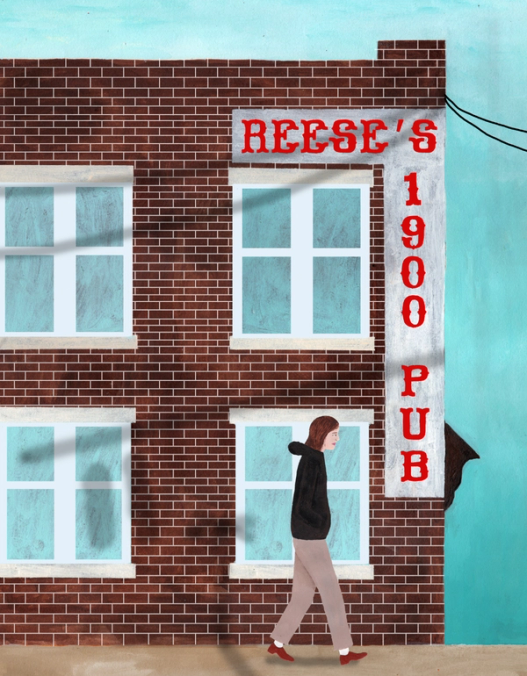I got to know Patchogue best right before I left it for good. After college, I was living at home, because I didn’t know where else to live, and I bought a pink Schwinn cruiser bicycle from the local Target with the middling money from my crappy full-time job. It had been years since I’d had a bicycle, having abandoned manual travel in my teens once my friends could drive, and so it was the first time I had this particular freedom without parental parameters setting rules for where I could and couldn’t go (never across Main Street; never over Route 112). My life felt dead in its tracks as I entered the limbo of wondering whether to go to grad school or keep working, and what nursed the existential unease was peddling down to the bay, imagining myself becoming a townie eccentric, biking every day past the pub and the pork store.
Soon enough, I’d find a magazine job and move, leaving Patchogue to become unrecognizable to me. It had been dead for so long that I don’t think anyone expected the resurrection that would occur in the late-2000s, renewing the town midway through Long Island’s south shore to its long-ago heyday of sorts, when fishing and milling made it an official US port of entry at the turn of the 19th century.
The name (pronounced patch-ahg) comes from the Algonquin language, in which “Pochaug” means “a turning place” or “where two streams separate,” according to Patchogue: A Brief History, a pamphlet put out by the local public library. By the 18th century, it was a mill town, making paper, twine, cloth, wool, carpet, lumber, leather and iron products. It was the Patchogue-Plymouth Lace Mill that became the biggest business for its tablecloths and curtains; they converted during World War II to produce parachutes and other textiles needed by the armed forces. Oysters and clams had also been big business, employing 350 people in 1850. “Famous Blue Point oysters were canned and shipped from Patchogue all over the world,” notes the town history.
Its achievements as a milling and fishing town set the stage for it to become a destination in the first half of the 20th century, with hotels and entertainment; during Prohibition, it was even a hub for rumrunners who knew the coastline and smuggled in bottles of booze to speakeasies and well-heeled locals. The emergence of malls in the mid-20th century gradually killed off local boutiques, leading the village into the few desolate decades of decay during which I grew up . A few stores survived: Family Melody Center, opened in 1956, is where I got rosin for my violin bow and took lessons after school; Swezey’s, a department store, is where many local kids got their first jobs; Blum’s and Richard York Shoes still supply fashions for an aging population. For decades, it was a town hanging on by thread and goodwill.
There was also that pub and the pork store, twin representatives of Patchogue’s essence. Reese’s 1900 and Delfiore Pork Store both opened in 1971. The former is a Cheers-esque Irish bar with brass railings sparkling and generous pours of Jameson, and the latter, across the street, is where one goes for marinara and braciole already stuffed, tied up with twine, ready for the oven. Located on South Ocean Avenue, which bifurcates Main Street going north and south. It makes sense in a place where everyone claims some Irish and/or Italian ancestry, where a taste for whiskey and knowing how to make good spaghetti are the backbones of the cultural identity.
These and all the restaurants that came and went—a good bakery, a Thai spot, even a massive, upscale French-food palace called Louis XVI—showed me that what keeps a place running, what is its lifeblood, are its food and drink. Though so much came and went, these two places remained open, and despite all that’s changed, they still define the town’s character.
Craft beer marked a turning point in the town named “a turning place.” BrickHouse Brewery opened in a historic building in 1996, and Blue Point Brewery followed in a tiny space in 1998 before becoming the behemoth it is now, producing 54,000 barrels per year in a building constructed upon the land that once housed the lace mill. (An on-the-nose changing of the guard for significant local industry.) These brought in younger people who were interested in what was a hot new thing, and condominium development and new restaurants followed in order to house and feed them. Now Patchogue is almost too alive, teeming with stumbling hordes on weekend nights who vomit in the street and go viral for embarrassing fistfights. People line up for brunch at Toast Coffeehouse and Buttermilk Kitchen. Where there was once a boat store, the Bargain Bilge, there is now a Starbucks with a drive-through.
25 years ago. The town I came from was nowhere, but at least it had a pub and a pork store—those I’ve always known what to do with; those you come out of the womb understanding in Patchogue. But I still wonder who I’d be if there had been more.
Alicia Kennedy is a writer from Long Island living in San Juan, Puerto Rico. She has a weekly newsletter on food culture, media, and politics, and her first book—No Meat Required: The Cultural History and Culinary Future of Plant-Based Eating—will be out on August 15, 2023.
